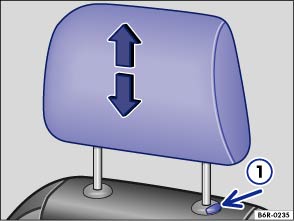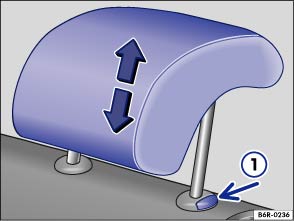Volkswagen Polo Owners Manual: Adjusting the head restraints

Fig. 39 Adjusting front head restraint

Fig. 40 Adjusting rear head restraint
 First read and observe the introductory information
and safety warnings
First read and observe the introductory information
and safety warnings
Every seat is fitted with a head restraint. The centre rear head restraint is designed solely for use with the centre rear seat. This head restraint should therefore not be installed in any of the other positions.
Adjusting the height
- Push the head restraint up in the direction of the arrow or push it down with the button pressed or .
- The head restraint must click securely into position.
Correct head restraint setting
Adjust the head restraint so that its upper edge is at the same height as the top of the head, but not lower than eye level. Position the back of your head as close to the head restraint as possible.
Head restraint setting for shorter people
Push the head restraint all the way down, even if the head is then underneath the top edge of the head restraint. There may be a small gap between the head restraint and backrest in the lowest position.
Head restraint setting for taller people
Push the head restraint up as far as it will go.

 WARNING
WARNING
- If a seat is occupied, the head restraint for that seat must be fitted and adjusted correctly.
- Each vehicle occupant must adjust the head restraint to suit their body size, to help reduce the risk of neck injuries in an accident. As far as possible, the upper edge of the head restraint must be level with the top of the head, but not lower than eye level. Position the back of your head as close to the head restraint as possible.
- Never adjust the head restraint when the vehicle is in motion.
 Mechanical controls on the front seats
Mechanical controls on the front seats
Fig. 37 Front left seat controls with
convenient entry function.
Fig. 38 Front right seat controls without
convenient entry function.
First read and observe the introductory information
and ...
 Removing and fitting head restraints
Removing and fitting head restraints
First read and observe the introductory information
and safety warnings
Every seat is fitted with a head restraint. The centre rear head restraint is
designed solely for use with the centre rear ...
Other materials:
Plastic Primer
Adhesion Promoter (Glazing)
Definition:
Adhesion Promoter -ALO 822 000 10- (glazing)
Edition 06/2011
Product Description
The glazing adhesion promoter is a universal
single- ...
Warranty Test, Performing
WARNING
Do not check or charge batteries that have a visual
indicator that is bright yellow. Jump starting must not
be used!
There is a risk of explosion during testing,
cha ...
One-Part Anti-Corrosion Primer
Definition:
One-Part Anti-Corrosion Primer -LLS MAX 003 M2-, reddish
brown
Edition 03/2013
Product Description
The One-Part Anti-Corrosion Primer -LLS MAX 003 M2- is a
...
